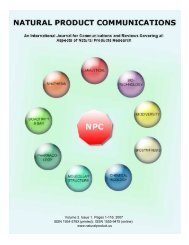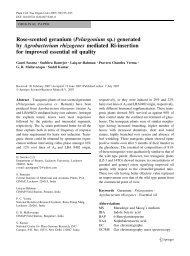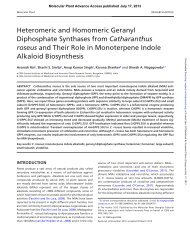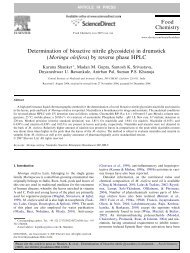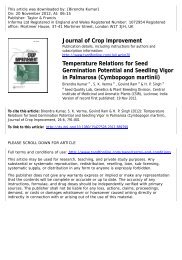<strong>Analysis</strong> <strong>of</strong> <strong>hairy</strong> <strong>root</strong> <strong>culture</strong> <strong>of</strong> <strong>Rauvolfia</strong> <strong>serpentina</strong> ORIGINAL RESEARCH 597to screen and select the best performer amongst a wider,independently generated, heterogeneous background,as reported in earlier analogous studies (Christey andBraun, 2005). Chemical pr<strong>of</strong>iling <strong>of</strong> a large number <strong>of</strong>independently generated <strong>hairy</strong> <strong>root</strong> clones through theapplication <strong>of</strong> conventional complex solvent extractionprocess is undeniably a herculean task.In order to pr<strong>of</strong>ile the <strong>hairy</strong> <strong>root</strong> clones <strong>of</strong> <strong>Rauvolfia</strong><strong>serpentina</strong> quickly and with great accuracy for the characterization<strong>of</strong> the indole alkaloids expressed in them,we have utilized a new mass spectrometric ionizationtechnique, DART (direct analysis in real time). DARTis coupled to a time-<strong>of</strong>-flight mass analyzer that providesselectivity and accurate elemental composition assignmentthrough exact mass measurement. The DARTtechnique has been found to be extremely useful fordirect detection <strong>of</strong> chemicals on surfaces withoutrequiring sample preparation such as solvent extraction.In this communication, we report the identification<strong>of</strong> two alkaloids, vomilenine and reserpine, that wereexpressed in the <strong>hairy</strong> <strong>root</strong> <strong>culture</strong>s <strong>of</strong> R. <strong>serpentina</strong> bydirectly analyzing the <strong>hairy</strong> <strong>root</strong>s using the DARTspectrometric method. The structures <strong>of</strong> the two alkoidswere confirmed as vomilenine (1) and reserpine (2) byexact measurement <strong>of</strong> their molecular formulae. Tothe best <strong>of</strong> our knowledge, this is the first report <strong>of</strong>chemical pr<strong>of</strong>iling <strong>of</strong> the <strong>hairy</strong> <strong>root</strong>s <strong>of</strong> plant tissue<strong>culture</strong> origin using DART technique. Moreover, thisis also the first report <strong>of</strong> expression <strong>of</strong> reserpine in the<strong>hairy</strong> <strong>root</strong> <strong>culture</strong> <strong>of</strong> R. <strong>serpentina</strong>.EXPERIMENTALInduction and establishment <strong>of</strong> <strong>hairy</strong> <strong>root</strong>s. <strong>Rauvolfia</strong><strong>serpentina</strong> plants (8–10 weeks), maintained under in-vitroconditions on semisolid MS (Murashige and Skoog, 1962)medium supplemented with 2.0 mg/L 6-benzylaminopurine(BAP) and 0.1 mg/L α-naphthalene acetic acid (NAA), wereused as the explant source. The young leaves were inoculatedthrough pricking with a 48-h-old suspension <strong>culture</strong><strong>of</strong> A. rhizogenes strain A 4 (a kind gift from Pr<strong>of</strong>essor D.Tepfer, INRA, Versailles Cedex, France), grown in liquidYMB (Hooykass et al., 1977) medium (O.D. 600 = 0.9–1.0) andco-<strong>culture</strong>d on hormone-free, semi-solid MS medium. After48 h <strong>of</strong> co-cultivation with the bacterial strain, the explantswere transferred on to the same medium containing 1.0 g/L <strong>of</strong>Cephalaxin (Ranbaxy, India) under dark conditions. Similartypes <strong>of</strong> explants, pricked with a sterile needle devoid <strong>of</strong> thebacterial suspension, were <strong>culture</strong>d under uniform conditionsas controls. The emerging <strong>hairy</strong> <strong>root</strong>s were subsequentlytransferred to the half and full strengths <strong>of</strong> the MS mediumcontaining 3% (w/v) sucrose for their further proliferation.Once established, the individual <strong>hairy</strong> <strong>root</strong> clones were transferredto liquid MS medium with the same concentration<strong>of</strong> antibiotic and incubated on a rotary shaker in the dark at25 ± 1°C under constant agitation (80 rpm). The antibioticconcentration was progressively lowered and finally completelyomitted after 4 months. Roots excised from in-vitrogrown complete plantlets were <strong>culture</strong>d under identical conditionsin liquid MS medium supplemented with 1.0 mg/Lindole-3-butyric acid (IBA) to serve as control <strong>root</strong>s.Characterization <strong>of</strong> <strong>hairy</strong> <strong>root</strong>s. Polymerase chain reactionanalysis was carried out to prove the transformed nature <strong>of</strong>the independently generated <strong>hairy</strong> <strong>root</strong> clones following apublished procedure (Rahman et al., 2004).DART mass spectrometryThe mass spectrometer used was a JMS-100 TLC (AccuT<strong>of</strong>)atmospheric pressure ionization time-<strong>of</strong>-flight mass spectrometer(Jeol, Tokyo, Japan) fitted with a DART ion source.The mass spectrometer was operated in positive-ion modewith a resolving power <strong>of</strong> 6000 (full-width at half-maximum).The orifice 1 potential was set to 28 V, resulting in minimalfragmentation. The ring lens and orifice 2 potentials were setto 13 and 5 V, respectively. Orifice 1 was set to a temperature<strong>of</strong> 100°C. The RF ion guide potential was 300 V. Data acquisitionwas from m/z 10 to 1050. The DART ion source wasoperated with helium gas flowing at approximately 4 L/min.The gas heater was set to 300°C. The potential on the dischargeneedle electrode <strong>of</strong> the DART source was set to 3000 V, electrode1 to 100 V and the grid to 250 V. The sample (<strong>hairy</strong><strong>root</strong>) was positioned in the gap between the DART sourceand mass spectrometer for measurements. Exact mass calibrationwas accomplished by including a mass spectrum <strong>of</strong> neatpolyethylene glycol (1:1 mixture PEG 200 and PEG 600)in the data file. The mass calibration was accurate to within± 0.003 u. Using the Mass Center s<strong>of</strong>tware, the elementalcomposition could be determined on selected peaks.RESULTS AND DISCUSSIONEmergence <strong>of</strong> <strong>hairy</strong> <strong>root</strong>s could be seen after four weeks<strong>of</strong> bacterial inoculation <strong>of</strong> the leaf explants with the A.rhizogenes strain A 4 at 81.25% relative transformationfrequency. In accordance with an earlier report (Benjaminet al., 1993), most <strong>of</strong> the emerging <strong>root</strong>s <strong>of</strong> the presentstudy tend to form calli in the half-strength, hormonefree,liquid basal MS medium during further sub-culturing.However, on the basis <strong>of</strong> potential to grow without callusingalong with maximum elongation and branchingbehavior, one particular <strong>hairy</strong> <strong>root</strong> clone could be selectedfor further studies out <strong>of</strong> 30 independent <strong>hairy</strong><strong>root</strong> lines. The selected <strong>hairy</strong> <strong>root</strong> clone exhibited anRol-A-positive result, which indicated its transformednature. The biosynthetic potential <strong>of</strong> this particular<strong>hairy</strong> <strong>root</strong> clone has been evaluated through application<strong>of</strong> the newly developed DART technique.Mass spectrometry is a very important tool for thedetermination <strong>of</strong> molecular weight and structure determination<strong>of</strong> organic molecules. It has also been utilizedin the field <strong>of</strong> biotechnology as one <strong>of</strong> the core methodsfor characterization <strong>of</strong> different compounds. TheCopyright © 2008 John Wiley & Sons, Ltd. Biomed. Chromatogr. 22: 596–600 (2008)DOI: 10.1002/bmc
598 ORIGINAL RESEARCHK. P. Madhusudanan et al.different ion sources that have been used in massspectrometry include electron ionization, chemical ionization,fast atom bombardment, field desorption/fieldionization, electrospray ionization and matrix-assistedlaser desorption ionization.DART, a new ionization source, has recently beendeveloped by Cody and Laramee (Cody et al., 2005). InDART, the sample is not directly exposed to highvoltages, laser beams, radiation or plasma. DART iscoupled with a time-<strong>of</strong>-flight mass spectrometer. DARTis based on the atmospheric pressure interaction <strong>of</strong>long-lived electronic excited state atoms or vibronicexcited state molecules with atmospheric gases and thesample. Helium or nitrogen is used for producingthe ionizing plasma. The gas flows through a chamberwhen an electric discharge (corona discharge) producesions, electrons and excited state metastable atoms andmolecules. These metastable species, in turn, generateprotonated gaseous water clusters in ambient air. Thewater clusters on proton exchange with the sample giverise to [M + H] + ions <strong>of</strong> the sample. Thus, proton transferis the dominant mechanism in positive ionization. Innegative ionization mode, oxygen water clusters arereported to be responsible for ionizing the sample. TheDART gas flow is towards the mass spectrometer inletorifice across a gap <strong>of</strong> 5–25 mm. This gap is opened tothe laboratory room and the material to be analyzed isheld in this gap in the stream <strong>of</strong> warm gas. The DARTion source has been used to analyze an extremely widerange <strong>of</strong> analytes including drugs (tablets, formulationsetc.), metabolites in body fluid, explosives, forensic substances,synthetic-organic and organo-metallic compounds,food, spices, beverages, fatty acids in bacteria andalso materials on surfaces such as paper or currency.Recently, we have utilized the DART technique forthe detection and identification <strong>of</strong> taxoid molecules thatwere expressed in the cell <strong>culture</strong> <strong>of</strong> Taxus wallichiana(Banerjee et al., 2007).The <strong>hairy</strong> <strong>root</strong> <strong>culture</strong>s <strong>of</strong> different <strong>Rauvolfia</strong> specieshave been explored in the past in the search for analternative source <strong>of</strong> reserpine. However, in the firstreport, 40-day-old <strong>hairy</strong> <strong>root</strong> <strong>culture</strong>s <strong>of</strong> R. <strong>serpentina</strong>produced only trace amounts <strong>of</strong> <strong>serpentina</strong>, while allthe other targeted indole alkaloids, i.e. reserpine, ajmalineand raucaffricine, remained absent (Benjamin et al.,1993). The same research group subsequently revealedthat pure <strong>hairy</strong> <strong>root</strong> <strong>culture</strong>s without the problem<strong>of</strong> callusing could never be obtained in R. <strong>serpentina</strong>and the mixed <strong>hairy</strong> <strong>root</strong> + callus <strong>culture</strong>s produced onlyajmaline (0.045% dry weight [DW]) and serpentine(0.007% DW; Benjamin et al., 1994). Klyushnichenkoet al. (1995) later reported yohimbine as the majoralkaloid on a backdrop <strong>of</strong> small unidentified impuritiesin the <strong>hairy</strong> <strong>root</strong> <strong>culture</strong>s <strong>of</strong> R. <strong>serpentina</strong> and R.vomitoria. Sheludko et al. (2002a,b), on the other hand,have reported the synthesis indole alkaloid <strong>of</strong> raumaclinegroup and a new alkaloid <strong>of</strong> the sarpagine group in the<strong>hairy</strong> <strong>root</strong> <strong>culture</strong>s <strong>of</strong> R. <strong>serpentina</strong>. Recently Sudhaet al. (2003) have also reported the production <strong>of</strong>ajmalicine and ajmaline in the <strong>hairy</strong> <strong>root</strong> <strong>culture</strong>s <strong>of</strong>R. micrantha.As DART is a new ionization technique and itssensitivity is quite high, we have decided to analyze the<strong>hairy</strong> <strong>root</strong>s <strong>of</strong> R. <strong>serpentina</strong> by this technique as it hasnot yet been applied for this purpose. The intact <strong>hairy</strong><strong>root</strong>s <strong>of</strong> R. <strong>serpentina</strong> were held in front <strong>of</strong> the DARTsource. A mass spectrum was instantly obtained (Fig. 2).The peaks at m/z 351 and 609 were assigned to the [M+ H] + <strong>of</strong> two nitrogen-containing compounds. The twonitrogen containing compounds (alkaloids) were characterizedas vomilenine (1) and reserpine (2) (Fig. 1) onthe basis <strong>of</strong> their exact mass measurement which gaveFigure 1. Chemical structures <strong>of</strong> vomilenine (1) and reserpine (2).Copyright © 2008 John Wiley & Sons, Ltd. Biomed. Chromatogr. 22: 596–600 (2008)DOI: 10.1002/bmc




